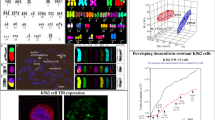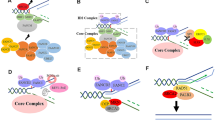Abstract
Telomeres and telomerase have been subjects to a tremendousattention from scientists and oncologists during the past 5 years.This interest has been motivated by the potential of telomerase asa tumor marker for the diagnosis and the prognosis of cancer.The possible use of telomerase or telomeres as new targets foranticancer drugs also triggered investigations. The expression of telomerasewas found in overall 85% of cancers. Telomerase is early expressedduring oncogenesis with a gradient indicating that a high level oftelomerase expression could be associated with a bad prognosis.Therefore, drugs targeting telomerase and telorneres might beuseful in many human tumors with little restrictions regarding thetumor type or on the stage of the disease. Moreover, sincetelomerase is not or slightly expressed in normal cells, it hasbeen postulated that drugs targeting telomerase would induce lowtoxicity.
The race for the discovery of telomerase inhibitors has startedwhile the identification of the components controlling telomerase,telomeres, cell survival, senescence, and apoptosis was still inprogress. The recent identification of components regulatingtelomere length and telomerase expression (TRF1, TRF2, andtankyrase) opened a variety of new opportunities to controltelomerase/telomere interactions. Meanwhile, a proof of principlewas provided that changing telomere interactions with telomere binding proteins by chemical or biological means can induce cancercell death. Interestingly, recent data challenge the old paradigm whichsuggested that a long exposure to telomerase and telomereinhibitors is necessary to induce anticancer effects.
In this paper, we review the most recent information concerning theregulation of telomere length and telomerase expression, withemphasis on mechanisms that might translate into new drugdiscovery.
Similar content being viewed by others
References
Moyzis RK, Buckingham JM, Crain LS, et al.: A highly conserved repetitive DNA sequence (TTAGGG)n, present at the telomeres of human chromosomes. Proc Mad Acad Sci 85: 6622–6626, 1988
Cheng JF, Smith CL, Cantor CR: Isolation and characterization of human telomere. Nucleic Acid Res 17: 61109–61127, 1989
Blackburn EH: Structure and function of telomeres. Nature 350: 569–573, 1991
Shippen DE: Telomeres and telomerases. Curr Opin Gen Dev 3: 759–763, 1993
Zakian VA: Telomeres: beginning to understand the end. Science 270: 1601–1607, 1995
Pommier JP, Lebeau J, Ducray C, Sabatier L: Chromosomal instability and alteration of telomere repeat sequences. Biochimie 77: 817–825, 1995
Harley CB, Futcher AB, Greider CW: Telomeres shorten during ageing of human fibroblasts. Nature 345: 458–460, 1990
Allsopp RC, Vaziri H, Patterson C, Goldstein S, Younghai EV, Futcher AB, Greider CV, Harley CG: Telomere length predicts replicative capacity of human fibroblasts. Proc Natl Acad Sci 89: 10114–10118, 1992
Kim NW, Pitayszek MA, Prowse KR, Harley CB, West MD, Ho PLC et al.: Specific association of human telomerase activity with immortal cells and cancer. Science 266: 2011–2015, 1994
Broccoli D, Young JW, De Lange T: Telomerase activity in normal and malignant hematopoietic cells. Proc Mad Acad Sci 92: 9082–9086, 1995
Yasumoto, S, Kunimura C, Kukuchi K, Tahara H, Ohyi H, Yamamoto H et al.: Telomerase activity in normal human epithelial cells. Oncogene 13: 433–439, 1996
Hiyama E, Hiyama K, Tatsumoto N, Kodama T, Shay JW, Yokoyama T: Telomerase activity in human intestine. Int J Oncol 9: 453–458, 1996
Rhyu MS: Telomeres, telomerase and immortality. J Natl Cancer Inst 87: 884–894, 1995
Strahl C, Blackburn EH: Effects of reverse transcriptase inhibitors on telomere length and telomerase activity in two immortalized cell lines. Mol Cell Biol 16: 53–65, 1996
Norton JC, Pitatyszek MA, Wright WE, Shay JW, Correy DR: Inhibition of human telomerase activity by peptide nucleic acids. Nat Biotech 14: 615–619, 1996
Raymond E, Sun D, Chen SF, Windle B, Von Hoff DD: Agents that target telomerase and telomeres. Curr Opin Biotech 7: 583–591, 1996
Sharma S, Raymond E, Soda H, San DK, Hilsenbeck G, Sharma A et al.: Preclinical and clinical strategies for development of telomerase and telomere inhibitors. Ann Oncol 8: 1063–1074, 1997
Bilaud T, Brun C, Ancelin K, Koering CE, Laroche T, Gilson E: Telomeric localization of TRF2, a novel human telobox protein. Nat Genet 17: 236–239, 1997
van Steensel B, de Lange T: Control of telomere length by the human telomeric. protein TRF 1. Nature 385: 740–743, 1997
Smith S, Giriat 1, Schmitt A, de Lange T: Tankyrase, a poly(ADP-ribose) polymerase at human telomeres. Science 282: 1484–1487, 1998
Faragher RGA: Telomerase and cellular lifespan: Ending the debate. Nature Biotech 16: 701–702, 1998
Kipling D, Wynford-Thomas D, Jones CJ, Akbar A, Aspinall R, Bacchetti S, Blasco MA, Broccoli D, DePinho RA, Edwards DR, Effros RB, Harley CB, Lansdorp PM, Linskens MH, Prowse KR, Newbold RF, Olovnikov AM, Parkinson EK, Pawelec G, Ponten J, Shall S, Zijlmans M, Faragher RG: Telomere-dependent senescence. Nat Biotechnol 17[4]: 313–314, 1999
Shay JW, Van Der Haegen BA, Ying Y, Wrigth WE: The frequency of immortalization of human fibroblasts and mammary epithelial cells transfected with SV40 large T-antigen. Exp Cell Res 209: 45–52, 1993
Counter CM, Avilion AA, Lefeuvre CE, Stewart NG, Greider CW, Harley CB, Bacchetti S: Telomere shortening associated with chromosome instability is arrested in immortal cells which express telomerase activity. EMBO J 11: 1921–1929, 1992
Mealy KC: Telomere dynamics and telomerase activation in tumor progression: prospects for prognosis and therapy. Oneol Res 7: 521–529, 1995
Park KH, Rha SY, Kim CH, Kim TS, Yoo NC, Kim JH, Roh JK, Noh SH, Min JS, Lee KS, Kim BS, Chung HC: Telomerase activity and telomere, lengths in various cell lines: changes of telomerase activity can be another method for chemosensitivity evaluation. Int J Oncol 13: 489–495, 1998
Ducray C, Pommier P, Martins L, Boussin F, Sabatier L: Telomere dynamics, end-to-end fusions and telomerase activation during human fibroblast immortalization process. Oncogene 18/28: in press, 1998
Bodnar AG, Ouelette M, Frolkis M, Holt SE, Chiu GP, Morin GB et al.: Extension of life-span by introduction of telomerase into normal human cells. Science 279: 349–352, 1998
Blasco MA, Lee HW, Hande MP, et al.: Telomere, shortening and tumor formation by mouse cells lacking telomerase RNA. Cell 91: 25–34, 1997
Lansdorp PM: Lessons from mice without telomerase. J Cell Biol 139: 309–312, 1997
Lee HW, Blasco MA, Gottlieb GJ, Homer JW, Greider CW, DePinho RA: Essential role of mouse telomerase in highly proliferative organs. Nature 392: 569–574, 1998
Marcand S, Gilson E, Shore D: A protein-counting mechanism for telomere length regulation in yeast. Science 275: 986–990, 1997
van Steensel B, Smogorzewska A, de Lange T: TRF2 protects telomeres from end-to-end fusions. Cell 92: 401–413, 1998
Broccoli D, Smogorzewska A, Chong L, de Lange T: Human telomeres contain two distinct Myb-related proteins, TRF1 and TRF2. Nat Genet 17: 231–235, 1997
Shore D. Telomeres-Unsticky ends. Science 281: 1818–1819, 1998
Gravel S, Larrivee M, Labrecque P, Wellinger RJ: Yeast Ku as a regulator of chromosomal DNA end structure. Science 280: 741–744, 1998
Dynan WS, Yoo S: Interaction of Ku protein and DNA-dependent protein kinase catalytic subunit with nucleic acids. Nucleics Acids Res 26: 1551–1559, 1998
Karlseder J, Broccoli D, Dai Y, Hardy S, de Lange T: p53-and ATM-dependent apoptosis induced by telomeres lacking TRF2. Science 26;283[5406]: 1321–1325, 1999
Karlseder J, Broccoli D, Dai Y, Hardy S, de Lange T: P53 and ATM-dependent apoptosis induced by telomeres lacking TRF2. Science 283: 1321–1325, 1999
Olivero OA, Gomez DE, Kassim A, Windle BE: Preferntial incorporation of 3′-azido2′,3′-dideoxythymidine (AZT) into telomeric DNA of chinese hamster ovary (CHO) cells. Proc Am Ass Can Res 35: 340, 1994
Yegorov YE, Chemov DN, Akimov SS, et al.: Reverse transcriptase inhibitors suppress telomerase function and induce senescence-like processes in cultured mouse fibroblats. FEBS Lett 389: 115–118, 1996
Fletcher T, Salazar M, Chen S: Human telomerase inhibition by 7-deaza-2′-deoxypurine nucleoside triphosphates. Biochemistry 35: 15611–15617, 1996
lzbicka E, Nishioka D, Wu RS, von Hoff DD, Weitman S, Hurley L: Antiproliferative and chromosome destabilizing effects of novel quinolones. Proc Am Ass Cancer Res 40, 770, 1999
Yamakuchi M, Nakata M, Kawahara K, Kitajima 1, Maruyama I: New quinolones, ofloxacin and levofloxacin, inhibit telomerase activity in transitional cell carcinoma cell lines. Cancer Lett 11; 119[2]: 213–219, 1997
Joshi SS, Palen BN, Mata JE, Iversen PL: Growth inhibitory effects of telomere mimic oligonucleotides on human leukemia/lymphoma cells in vitro. Proc Annu Meet Am Assoc Cancer Res 36: A2455, 1995
Catapano, C.V., Pacheco, D., Carbone, G.M.R. McGuffie, E.M: Inhibition of human telomerase activity by foldback triplex-forming oligonucleotides (FTFOs). Proc Am Asso Cancer Res 40: 134, 1999
Burger AM, Double JA, Newell DR: Inhibition of telomerase activity by cisplatin in human testicular cancer cells. Eur J Cancer 33: 638–644, 1997
Ishibashi T, Lippard SJ: Telomere loss in cells treated with cisplatin. Proc Nad Acad Sci 95: 4219–4223, 1998
Foote MZ, Hurley LH: Ecteinascidin 743: A minor groove alkylator that bends DNA toward the major groove. Proc Am Ass Cancer Res 40: 1963, 1999
Nishioka D, Wu RS, Von Hoff DD, lzbicka E: Chromosome effects of ecteinascidin ET743 (ET-743) in a sea urchin embryo model. Proc Am Ass Cancer Res 40: 1994, 1999
Izbicka E, Davidson K, Lawrence R, Cote R, Rha SY, Mac-Donald JR, Von Hoff DD: Cytotoxic effects of MGI 114 are independent of tumor suppressor gene p53 and p2l expression. Proc Am Ass Cancer Res 40: 1993, 1999
Nishioka D, Wu RS, Rha SY, Von Hoff DD, lzbicka E: HMAF (6-hydroxymethylacylfulvene, MGI 114) induces chromosome destabilization in developing sea urchin embryos. Proc Am Ass Cancer Res 40: 17, 1999
Salazar M, Thompson BD, Kerwin SM, Hurley LH: Thermally induced DNA-RNA hybrid to G-quadruplex transitions: possible implications for telomere synthesis by telomerase. Biochemistry 35: 16110–16115, 1996
Sun D, Lopez-Guajardo CC, Quada J, Hurley LH, Von Hoff DD: Regulation of catalytic activity and processivity of human telomerase. Biochemistry 30; 38(13): 4037–4044, 1999
Sun D, Thompson B, Cathers BE, Salazar M, Kerwin SM, Trent JO, Jenkins TC, Neidle S, Hurley LH: Inhibition of human telomerase by a G-quadruplex-interactive compound. J Med Chem 4; 40(14): 2113–2116, 1997
Mata JE, Joshi SS, Palen B, Pirruccello SJ, Jackson JD, Elias N, Page TJ, Medlin Y-L, Iversen PL: A hexameric phosphorothioate oligonucleotide telomerase inhibitor arrests growth of Burkitt's lymphoma cells in vitro and in vivo. Toxicol Appl Pharmacol 144(1): 189–197, 1997
Kondo S, Kondo Y, Li G, Silverman RH, Cowell JK: Targeted therapy of human malignant glioma in a mouse model by 2–5A antisense directed against telomerase RNA. Oncogene 25; 16(25): 3323–3330, 1998
Fletcher TM, Sun D, Salazar M, Hurley LH: Effect of DNA secondary structure on human telomerase activity. Biochemistry 21; 37(16): 5536–5541, 1998
Perry PJ, Reszka AP, Wood AA, Read MA, Gowan SM, Dosanjh HS, Trent JO, Jenkins TC, Kelland LR, Neidle S: Human telomerase inhibition by regioisomeric disubstituted amidoanthracene-9,1O-diones. J Med Chem 19; 41(24): 4873–4884, 1998
Perry PJ, Gowan SM, Reszka AP, Polucci P, Jenkins TC, Kelland LR, Neidle S: 1,4-and 2,6-disubstituted amidoanthracene-9,10-dione derivatives as inhibitors of human telomerase. J Med Chem 13; 41(17): 3253–3260, 1999
lzbicka E, Wheelhouse RT, Raymond, E, Davidson KK, Lawrence RA, Sun D, Windle BE, Hurley LH, Von Hoff DD: Effects of cationic porphyrins as G-quadruplex interactive agents in human tumor cells. Cancer Res 59: 639–644, 1999
Raymond E, Sun D, lzbicka E, Mangold G, Silvas E, Windle B, Sharma S, Soda H, Laurence R, Davidson K, Von Hoff DD: A human breast cancer model for the study of telomerase inhibitors based on a new biotinylated-primer extension assay. Br J Cancer 80 (9): 1332–1341, 1999
Ku WC, Cheng AJ, Wang TC: Inhibition of telomerase activity by PKC inhibitors in human nasopharyngeal cancer cells in culture. Biochem Biophys Res Commun 29; 241(3): 730–736, 1997
Naasani 1, Seimiya H, Yamori T, Tsuruo T. FJ5002: a potent telomerase inhibitor identified by exploiting the disease-oriented screening program with COMPARE analysis. Cancer Res 59 (16): 4004–4011, 1999
Holt SE, Aisner DL, Baur J, Tesmer VM, Ouellette M, Trager JB, Morin GB, Tolf DO, Shay JW, Wright WE, White MA: Functional requirement of p23 and Hsp90 in telomerase complexes. Genes Dev 13 (7): 817–826, 1999.
Author information
Authors and Affiliations
Rights and permissions
About this article
Cite this article
Raymond, E., Soria, JC., lzbicka, E. et al. DNA G-Quadruplexes, Telomere-Specific Proteins and Telomere-Associated Enzymes as Potential Targets for New Anticancer Drugs. Invest New Drugs 18, 123–137 (2000). https://doi.org/10.1023/A:1006373812586
Issue Date:
DOI: https://doi.org/10.1023/A:1006373812586




